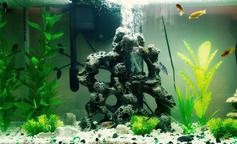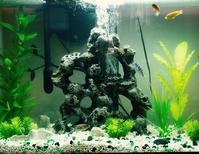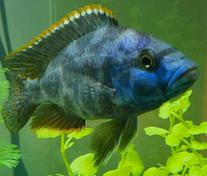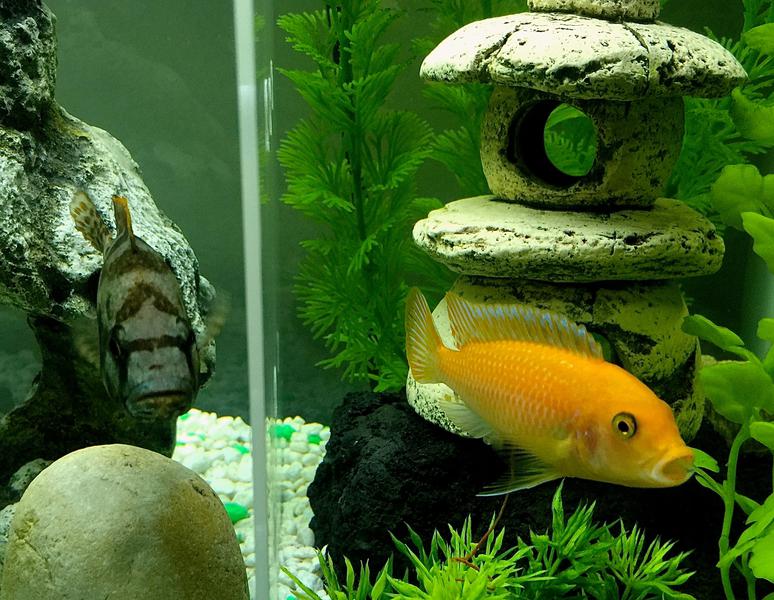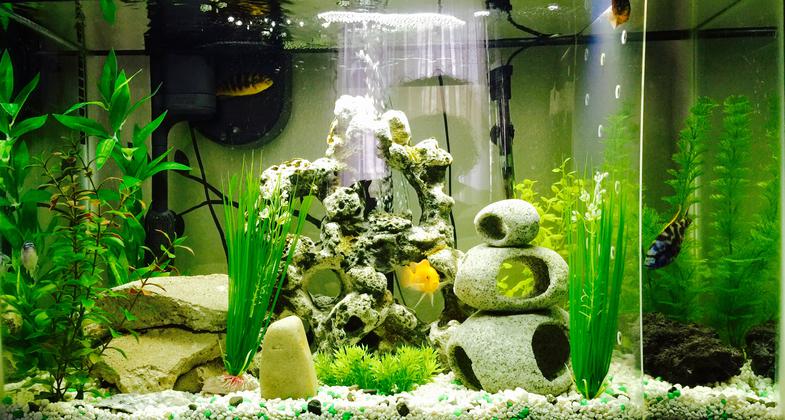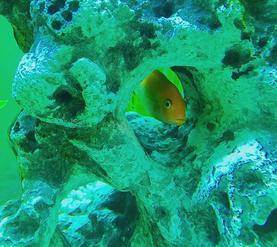 | ||||
African Cichlid
Tank Set-up & Care
African Cichlid Aquarium Set-up & Care
SPO VIRTUAL CLASSROOMS
 | ||||||
In August of 2015 we set up our first sizable aquarium and stocked it with African Cichlids.
This page provides information on how to set up an African Cichlid Aquarium and how to care for tAfrican Cichlids.
More Resources on Keeping African Cichlids
- CichlidAdvice.com: A Complete Beginners Guide
- African Cichlids from Animal World
- African Cichlid Aquarium Profile, Drs. Foster & Smith
- Cichlid Forum: Forums are a great way to connect with other Cichlid hobbyists, and find answers to common, and uncommon cichlid problems.
- African Cichlid Hub, another good forum, and there are several others, as well. Just Google "African Cichlid Forum".
General Requirements for African Cichlid Tank
Remember that different species of African Cichlids can vary widely in their needs. Research the types of cichlids you plan to get, so that you are aware of their specific requirements.
Tank Size: 29 gallon minimum. Get the largest tank you can afford and make space for.
Number of Fish: No more than 1" of adult cichlid size for each gallon of water.
Water temperature: ~75 degrees F.
Water pH: 7.2 - 9 (alkaline)
Nitrate, Nitrite & Chlorine Levels: Low!
Food: Floating pellets of other food specifically for Cichlids.
Page last updated 9/2017
 | ||||
Young children are natural born scientists, full of curiosity! Join the at-home experiments and explorations of a scientist mom & her kids.
 | ||||||
SPO is a FREE science education website. Donations are key in helping us provide this resource with fewer ads.
Please help!
(This donation link uses PayPal on a secure connection.)
You have FREE access to a large collection of materials used in a college-level introductory biology course. The Virtual Biology Classroom provides a wide range of free educational resources including PowerPoint Lectures, Study Guides, Review Questions & Practice Test Questions.
African Cichlids are colorful freshwater fish native to the Tanganyika, Malawi & Victoria Lakes of Central Africa. African Cichlids are full of personality, and many are territorial and aggressive. There's never a dull moment in a cichlid tank.
How To Set Up An Aquarium for African Cichlids
Keeping cichlids is a rewarding hobby that requires some dedication. The most essential factor in creating a successful cichlid tank is knowledge...researching the fish, and their requirements, well before setting up and stocking the tank.
There are many species of cichlids, each with their own environmental requirements and temperament. For a relatively peaceful tank, it is essential to research and plan.
Choosing Cichlids
Cichlids vary widely in their needs, personality and aggression level. Do your research and plan ahead! It is best to get cichlids when they are young and small, and introduce them to the tank at the same time. Smaller fish are more affordable, and younger fish are going to have a lower level of aggression, and more time to become accustomed to each other, than if adding larger, mature fish.
Variety
Some hobbyist want a tank with a variety of species. This requires research into the relative aggression level and potential targets (fish similar in color and appearance). Fish of the same species, or similar in appearance, usually show more aggression to each other.
Tami Port, MS
Chief Executive Nerd of Science Prof Online & College Biology Instructor
Choosing the right mix of cichlids is essential in managing tank aggression. This Livingston cichlid, although beautiful, is highly aggressive, and causes many problems in our tank.
African Cichlid Aggression
Livingston (Mojo) and Peacock (Charlotte) engaging in aggressive behavior, first with open-mouth aggression, then Charlotte begins to "shimmer." Shimmering is a shaking display that cichlids do both as territorial aggression and breeding.
Breeding
Cichlids are relatively easy to breed in captivity, many are "mouth brooders", with the female or male carrying the fry in their mouth for protection. If you are interested in breeding cichlids, make sure that you have a plan for what to do with the offspring.
Setting Up Cichlid Tank
Our Tank
We keep our cichlids in a 29-gallon tank. If you follow the 1 inch of maximum fish size per gallon rule, we are way over (at 40' of adult-sized fish). Some hobbyists crowd fish to reduce aggression; the idea being that with many fish, none are able to secure a territory, and therefore they fight less. That's not working in our tank, as we are seeing physical aggression.
Equipment needed:
- The largest tank that you can afford, and find space for (at least 29 gallons)
- Hood for tank with light
- Filter & refill filter cartridges
- Thermometer (72 - 82 degrees Fahrenheit. Wee keep our tank ~75 degrees F.)
- Heater (Most heaters keep water temperature ~75 degrees F. Some can be adjusted)
Supplies Needed:
- Food - cichlid pellets and/or flakes (I prefer floating pellets.)
- Aquarium bacteria (Found in products like Tetra's SafeStart.)
- Water conditioner
- pH adjuster (cichlids need an alkaline pH, ranging from 7.2 - 9, depending on the species. Water is usually has a pH of around 7. So you may need a pH increaser, like TopFin's pH Increase. We live in Michigan and have alkaline well water, so do not have to do much pH adjustment.)
- Net for catching fish
- Aquarium test strips, such as Tetra Easy Strips, to test water pH, nitrogen (nitrate, nitrite), hardness & chlorine.
How To Care For African Cichlids
Cleaning Tank
About every two weeks, the tanks should be cleaned using a syphon with gravel vacuum, removing and replacing 20% of the water. Be sure to check new water for chlorine and use chlorine neutralizer if necessary, before adding the water to the tank. Also make sure that new water is a similar temperature to the tank water.
Remove all plastic plants and "furniture" from tank to make it easier to vacuum the gravel. It is easiest to put these in a bucket while cleaning the tank.
Do not change filter every time you clean the tank. This would remove important bacteria. Just rinse the filter off is on old tank water you remove from the tank.
Supplies Needed for Cleaning:
- gravel vacuum
- two large buckets (one for water change, the other for tank decor)
- towels for floor and wiping hands
- algae scrubber (hard bristle toothbrush works too)
- chlorine neutralizer (if your water is chlorinated)
- bacteria product (such as SafeStart)
- any other products that you need to ad to the water
For a detailed description of proper cichlid tank cleaning, with information by tank size and number of fish, see African Cichlid Tank Maintenance at Dan's African Cichlid Site.
Feeding African Cichlids
What To Feed: There are many different kinds of food appropriate for cichlids. Floating cichlid pellets are the main staple food I feed. Using floating pellets gives the fish more time to eat before the food falls to bottom of tank, and makes leftover pellets easy to remove.
Cichlids also like greens, such as spinach, occasionally, as well as dried animal foods, such as shrimp.
How Much to Feed: We feed our cichlids a little food twice a day, morning and evening. Only give them food as long as they are voraciously going after it. Overfeeding can lead to health problems such as bloat.
Livingson (spotted) and Red Zebra (orange) cichlids separated by plexiglass divider. Note Zebra's open mouth threat display. These guys don't care for each other.
The general rule for selecting a tank size is "the larger the better." Get the largest tank that you can afford and find space for. More space allows for less aggression and more options.
Tank Set-up
The tank needs to be set up well before introducing any fish. Generally, it is recommended that tanks be set up, with filter running, for about 4 weeks, before adding fish. This is necessary because the aquarium is a little ecosystem, and needs established aquatic bacteria to help manage the nitrogen levels in the tank.
Tank Furnishings:
- Rocky spots to hide in - Many cichlids like to have rocky crevices to hide in. Having many places for fish to hide can reduce tank aggression. There are many real and fake rock options offered in pet stores. We have a large, artificial rock that is also a bubbler, aerating the tank. If you get a bubbler, you will also need an air pump and plastic tubing. Be careful using rocks or bricks that you find. They may have materials that will leach into the water.
- Plastic plants - Avoid live plants. Many do not do well in the alkaline water. Plants in the tank also create more hiding places, reducing aggression.
- Aquarium gravel
